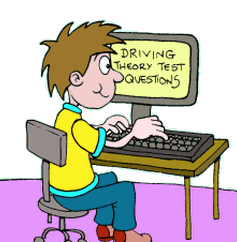The ABC of dealing with casualties
The ABC refers to how to treat casualties if you are involved in an accident but not injured, or indeed if you are at the scene where an accident occurs.
The A refers to the word airway. This means that if someone has stopped breathing then you should check their airway is clear.
The B refers to breathing. If you have cleared the airway of a person but their breathing does not start, then it may be that mouth to mouth resuscitation is required.
C is the last of the ABC and stands for the circulation. This means that you should check that the person has a pulse.
Providing first aid details is of course beyond the means of an article on a driving theory test questions website - you should seek expert advice on how to give and administer first aid; there are a series of courses that are offered regularly and first aid courses are of course generally useful for a large range of situations: trained first-aiders at work for instance will be able to advise you how to find out more on learning first aid.
The point is that you need to ensure you are able to do more good than harm and not vice versa.
Related Articles...
Driving and Eyesight Requirements
If you require glasses in order to meet the requirements for driving legally, then you must ensure that you wear them whilst you drive (or corrective lenses).
There are some conditions that...
Driving Theory Stopping Distances
Stopping distances refer to the distance that you car is going to travel from the time that you decide that you need to press the brake through the time that the vehicle physically stops...
Vehicle Test Certificate Explained
The MOT test is no doubt something you have heard of before, but you don't pay that much interest to what it actually is before you are a car driver and faced with the prospect of requiring such a...
Your vehicle's age is important
The age of your car is important for several reasons.
The main reason is that if your car is under three years old, there are four documents that you must be in possession of in relation to...
Motorway Driving Tips
Driving on a motorway for the first time can be both exciting and a little daunting - exciting as it is something new whilst daunting as you won't have experienced driving on a motorway before...
Some common engine faults
It is beyond the scope of the articles here to go into detail about how the engine works and what the various parts of it are. For the theory test you won't need to know a great detail about the...
Selecting low gears when driving
When you are driving, you will just learn to change gears without really thinking about what you are doing and when. But generally you will change up gears the faster you are going, and this is...
Reversing Exercises in the driving test
There are three reversing exercises that you could be tested on in the driving practical test.
You will be asked to perform two out of these three so that the person undertaking your test (the...
Road position and large vehicles
In a car there are of course blind spots, but as soon as you drive a lorry you realise how significant the blind spots are for those vehicles.
For one simple thing even with vans you can't...
How does the hazard perception test work
The hazard perception test is the second part of the driving theory test, and it was introduced towards the end of 2002.
There are two parts to the theory test, and the second part of the test...
Back to home page of driving theory test questions

